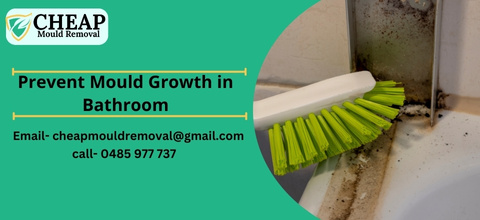Effective Steps to Prevent Mould Growth in Bathrooms

Bathroom mould is prevalent and, if untreated, may cause health problems and surface damage. An efficient way to deal with this issue is to hire a professional mould removal service. They will use their knowledge, specialized equipment, and safe cleaning agents to get rid of the mould and stop it from coming back. Those coping with severe growth or recurrent mould difficulties may find these services very beneficial.
The following procedures are usually included in professional mould removal:
- Specifying the kind of mould and its development rate
- Keeping the afflicted region contained to stop the spread of spores
- Catching airborne spores with HEPA filtration
- Mold removal with the use of targeted cleaning products
- Scrubbing and disinfecting the afflicted areas thoroughly
- Purification of the air by removing moisture
Bathrooms are often wet and humid, especially in the mornings and late evenings. However, mildew forms if the surfaces are not regularly cleaned and kept dry. If left unchecked, the mildew develops in mould. Therefore, mould cleaning becomes essential as if left to further grow can irritate, and be worse in the case of those who present allergic reactions.
In this blog, we will explore the different ways to prevent mould growth in bathrooms.
How to prevent mould growth
There are different varieties of mould like Aspergillus, Cladosporium, Penicillium, and Stachybotrys. These varieties mostly look dark brown or green, the most dangerous kind being black. Penicillium adds a green, yellowish, or blue tint to it.
Here are a few efficient ways to prevent the growth of mould in your bathrooms.
- Shower curtain: Mould thrives on damp shower curtains. The shower curtains should be arranged in a way that the steam produced during showers is allowed to escape.
- Change towels: Wash your shower or bath towels once a week. While you allow them to dry, for the following week, use another set of towels for your body and hands. Do not use fabric decorations in the bathrooms like artificial flowers.
- Ventilation: Ventilation refers to allowing air to pass in and out without any hindrance. So, after showering or bathing, make sure to keep the doors and windows open, especially during the day.
- Dry tiles: The bathroom tiles will get wet during showers. So, after taking a shower, dry not only the titles, but the shower tray, bathtub, joints, and other areas that do not dry off easily after taking a shower.
- Towels on the radiator: If you have a radiator at home, you can place your towels on them after you’ve used them. The radiator serves as a great way to dry your towel effectively. At the same time, any damp sports gear can be put in the washing machine.
- Use a dehumidifier: Use ceramic boxes or sachets filled with salt to attract moisture.
- Use a hygrometer: A hygrometer is a device that shows the level of air humidity. It can show you when optimum levels have crossed 50 to 70 per cent. When this happens, you can ventilate the room until the hygrometer reaches back to normal levels.
- Heating: The regular temperature in a bathroom is approximately 23 degrees. You could always leave the heating on in the bathroom if it is feasible for you or at regular times during the day if possible.
- Jointless bathroom: Modern bathrooms are most often constructed to be jointless, which prevents the growth of mould. So, if you can afford it, try getting your bathroom revamped.
Using the preventive methods, you can easily drive away any potential formation of mould. However, if the problem of mould has already begun, you can reach out to us to carry out our mould-cleaning services. We will conduct a free inspection of your bathroom and help you learn more about the areas that need urgent treatment.
